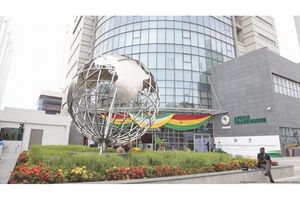The journey in the push for an all-inclusive democracy

President Jakaya Kikwete shares a moment with one of Tanzania’s key proponents of multi-party politics James Mapalala, who has since passed away. PHOTO | FILE
What you need to know:
- The renewed outcries for a new constitution mirrors the wave of 1992 when pro-democracy activists pushed authorities to abolish the one-party system
Dar es Salaam. As Tanzania marks 30 years since reintroducing the multi-party system, calls for a new constitution herald a fresh challenge towards deepening democratic gains for pluralism.
The renewed outcries for a new constitution mirrors the wave of 1992 when pro-democracy activists pushed authorities to abolish the one-party system ahead of the 1995 General Election.
The law amendment did away with the provisions that gave only CCM the rights of running politics within the United Republic of Tanzania, while other provisions were amended to allow a multi-party system, a resolution that was passed by Parliament on May 7, 1992 and officially approved on July 23.
Elections have since been held from 1995 to 2020, with CCM continuing to rule with a mixed bag of outcomes for the opposing parties that continue to seek an upper hand in their participation in governance matters of the country.
“The biggest challenge over the 30 years is that we still live in the country’s multi-party structure but the tool that runs the nation still is not compatible with the multi-party system.
“The tool I’m talking about here is the Constitution,” says Salum Mwalimu, Chadema’s deputy secretary general (Zanzibar) when asked about the state of democracy since the restoration of many parties.
Mwalimu, who, in the last elections was Tundu Lissu’s running mate in Chadema presidential race, says the current democratic culture that the winner should take everything is wrong, saying Zanzibar’s Government of National Unity (GNU) is a good example of parties sharing positions after an election.
His arguments concur with those of Richard Lyimbo, TLP’s general secretary.
“President Samia Suluhu has good intentions. She has created a good task force to look at this issue so that we all benefit from how we run our politics,” says Lyimbo.
“Now what to do is for Tanzanians to air their views. I have already given mine, that we need to have a political consensus. We need to have something to agree on and there should not be a political conflict.
Mr Mwalimu says the democratic space, despite the existing challenges, has opened up opportunities and reduced the one-party monopoly over ideas.
In a tweet, Chadema secretary general John Mnyika wrote: “July 1, 2022 will be 30 years since the multi-party democratic system was restored in 1992. This was supposed to be the #TheDayOfDemocracyInTanzania.”
He urged the government to lift the ban on public political rallies and speed up the process to re-start the new constitution writing process.
During Tanganyika’s independence in 1961, the country was a multi-party political state until 1965 when this arrangement was abolished by law due to the then prevailing conditions.
During this entire period up to the late 1980s when the country was a one-party state, the political movement was in a low profile until in the early 1990 when political and economic reforms began in Europe and later spread across the world.
Constitutional systems that were controlled by one political party opened up to allow the participation of other parties. The tide began to rise in the early 1990s.
Across Africa, the number of people who wanted multi-party system began to grow, putting pressure on regimes to open the door to political pluralism.
Few groups such as those of some intellectuals, the private media, workers, farmers, human rights activists were already at work demanding democratic change towards a multi-party system.
Transitional pressure on multi-party democracy in Tanzania began in the first half of the 1980s, towards the end of the administration of the first President, Mwalimu Julius Nyerere.
In 1983, the University of Dar es Salaam conducted a workshop and one of the presentations was on the need for multi-party democracy.
The following year, 1984, prominent human rights activist James Mapalala wrote an open letter to President Nyerere demanding for a change in the political system.
Mapalala and a few others were found with the letter and were arrested. Others, including two University of Dar es Salaam academics, were freed within a few days. Mapalala was detained for about four years until his release in 1989 due to changing political situations across the world.
In 1990, Mwalimu Nyerere made it clear that it was no longer a betrayal in Tanzania to discuss multipartism.
When pressure on taking concrete steps to change the multi-party system mounted, the government continued with dilly dallying, promising a referendum or the formation of a presidential commission to ask whether Tanzanians wanted such a change or not.
On February 26, 1991, a group of ten people met at the Agip Motel in Dar es Salaam, where they held a meeting to discuss changes and reforms in the country or the National Convention for Construction and Reform, whose acronym resulted in the name of the NCCR-Mageuzi party.
By then, Gabon had already held its first multi-party parliamentary election on September 16, 1990 and Ivory Coast on November 25, 1990.
The President of Togo also approved the country’s constitutional amendments to allow the system and polls took place on February 20, 1994.
The Mozambican parliament also unanimously approved the country’s constitutional amendments to introduce a multi-party system and finally a multi-party election was held on October 27-29, 1994.
A similar situation occurred in Congo-Brazzaville in August 1992 and Zimbabwe that held its multi-party election on March 23, 1990.
On February 19, 1991, one week before the group of ten people announced the formation of the NCCR-Reform, President Ali Hassan Mwinyi set up a commission to gather views on a viable system for Tanzania, which was led by Justice Francis Nyalali.
On the day, Mwinyi named only two members of the commission, chairman Nyalali and his secretary Julius Sepeku. A few days later he mentioned other members of the commission, including Mabere Marando, who, in his opinion, considered it inappropriate to ask Tanzanians about their rights.
Marando thanked President Mwinyi for appointing him, but he told the Head of State that he would not take part in the commission from which he withdrew.
Even before the constitutional and legal changes allowed the system of multi-party politics, there was a national construction and reform committee in the country comprising businessmen, lawyers, activists and students who eventually formed a party in 1991 called NCCR-Mageuzi. After the multi-party system officially began, NCCR-Mageuzi was registered on July 29, 1992.
Another party, the Civic United Union (CUF), was formed by James Mapalala after the merger of those who defected from NCCR-Reform and those who were members of KAMAHURU.
The fourth party was the United Democratic Party (UDP), which was founded by John Cheyo. Other parties were Chadema, UMD (Union for Multiparty Democracy) and Tadea (Tanzania Democratic Alliance).
According to a book titled Activist Origins of Political Ambition by Keith Weghorst, among the young people who became involved in multi-party politics even before the system was officially approved were Ismail Jussa and James Mbatia.
On page 16 of the book, he writes: “Neither Ismail Jussa nor James Mbatia planned to enter politics ...it is after being expelled from the University of Dar es Salaam that is when they found themselves attending meetings of the leadership committee of NCCR-Mageuzi on 21 and June 22, 1991 which led to a multi-party political movement. ”
In Tanzania, the reform activists who led the movement included Mabere Marando, James Mapalala, Chief Fundikira, Bob Makani and Edwin Mtei.






